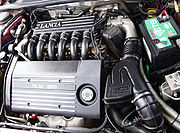
Lancia Kappa
Encyclopedia
The Lancia Kappa is an executive car
produced by Italian
automaker
Lancia
. It replaced the Thema
as Lancia's flagship model in 1994 and was itself replaced by Lancia Thesis
in 2001. It shared its platform
with the Alfa Romeo 166
and was available as a saloon, estate
or coupé
. The Kappa was only available in left-hand drive, as Lancia pulled out of right-hand drive markets after the demise of the Thema.
Kappa
is the tenth letter of the Greek alphabet
. Greek letters have frequently been used to denote Lancia models. Back in 1919, Lancia had already produced a Kappa (and its later evolutions called Dikappa and Trikappa), but these are far less known nowadays than the 1990s Kappa. In writing, Lancia often referred to the Kappa simply as the k (lower case "k"), which is fairly similar to the original Greek letter κ.
The Kappa was not particularly popular, with only 117,216 made in total. Italy remained Kappa's most important market, absorbing the bulk of sales. It is also worth noting that in Poland
, where Fiat Auto is the biggest domestic car manufacturer, Kappas served as official government cars (replacing Themas). This boosted the Kappa's profile in that country and gave it a peculiar cachet, which is why the Kappa enjoys a solid enthusiast base there.
Autocar's Peter Robinson reviewed the Kappa in November 1994 He commented on the car's bland styling which was justified by Fiat's Paolo Cantarella on the basis that the designers didn't want to create too much "visual noise." The body was reported as having twice the torsional rigidity of the outgoing Thema. It was 15% stiffer than any of its rivals. The automatic Aisin-Warner gearbox was shared with the Volvo 850. Robinson went on to say "the Kappa´s dimensions ensure a commodious interior, the impression of space only heightened by a low cowl and very Japanese-looking fascia, somewhere between a Honda NSX and Lexus LS400." Rear cabin room was described as "immense" but the cushion was criticised for being too flat, a fault rectified in later iterations of the car. Robinson criticised the "horrid mock wood with which Lancia frames the prominent central console that runs from the handbrake, up the full length of the dash and over the top." About the driving characteristics, Robinson wrote: "If Lancia quietened the starter motor, this would be one refined drivetrain...with no hint of any 5-cylinder unevenness." The 2.4 litre engine tested appeared to have been tuned for low-end torque, a characteristic of this Alpine brand. The engine was praised by Robinson for its "smooth responsiveness" and "torque steer has been eliminated...and the Servotronic steering is terrific, with just the right degreee of self-centering." His summary of ride and handling was that car was better than average but not class-leading: "On the Lancia there is too much body roll and the front grip in the wet didn´t inspire confidence."
and did not differ from the saloon exterior dimensions - the focus was clearly on presentation rather than cargo space.
The Coupé was designed and built by Maggiora
and technically quite different from the saloon, having a shorter wheelbase (by 120mm), wider rear track and a distinctive profile with frameless doors. The front, from bumper to the window screen, was identical to the other Kappas. It was Lancia's first coupé since 1984, when the Beta
and Gamma
coupés were discontinued, and remains the last Lancia to feature this body style to this day. The small building capacities at the Maggiora factory for this essentially hand-made car, and the relatively high price, destined it to be a rare vehicle. Only 3620 coupes were manufactured from April 1997 to March 2000, making this model a true rarity. Car magazine described the car as looking "top heavy, like a Bentley Continental that´s been heated up and squeezed at both ends." However, the car's engine range was praised for matching the vehicle's dynamics, the 2.4 litre five cylinder and the 3.0 Alfa-derived V6 coming closest to "infusing the k Coupe with the classy character its styling tries to suggest." "It´s the spiky turbo four that asks the hardest questions of the chassis and the all-strut suspension doesn´t flounder. It shines. A viscous coupling helps the front wheels cope with the onslaught of the engine´s old school, big-bang turbo delivery, and it feels remarkably untroubled." About the refinement and ride, John Barker (of Car Magazine) reported that the occupants "are completely isolated from any vibration while the ride is smooth at moderate speeds, parrying bumps quietly and unobtrusively." The interior was described as "appealing" and having "curvy, attractive door casings, plump supportive Recaro seats and choice plastics.". The 1997 price was estimated at 24,000 pounds sterling.
, all powering only the front wheels
. They were available with either a five-speed manual
or four-speed automatic transmission
, unless otherwise indicated.


Executive car
Executive car is a British term that refers to a car's size and is used to describe an automobile larger than a large family car. In official use, the term is adopted by EuroNCAP, a European organisation founded to test car safety.- History :...
produced by Italian
Italy
Italy , officially the Italian Republic languages]] under the European Charter for Regional or Minority Languages. In each of these, Italy's official name is as follows:;;;;;;;;), is a unitary parliamentary republic in South-Central Europe. To the north it borders France, Switzerland, Austria and...
automaker
Automaker
The automotive industry designs, develops, manufactures, markets, and sells motor vehicles, and is one of the world's most important economic sectors by revenue....
Lancia
Lancia
Lancia Automobiles S.p.A. is an Italian automobile manufacturer founded in 1906 by Vincenzo Lancia and which became part of the Fiat Group in 1969. The company has a long history of producing distinctive cars and also has a strong rally heritage. Some modern Lancias are seen as presenting a more...
. It replaced the Thema
Lancia Thema
The Lancia Thema is an executive car produced by the Italian automaker Lancia between 1984 and 1994, and one of four cars to share the Type Four platform alongside the Alfa Romeo 164, Fiat Croma and Saab 9000...
as Lancia's flagship model in 1994 and was itself replaced by Lancia Thesis
Lancia Thesis
The Lancia Thesis is an executive car produced by Italian automaker Lancia between 2002 and 2009. It was available with naturally aspirated and turbocharged engines ranging between 2.0 and 3.2 litres, in both straight-5 or V6 configurations. Its appearance was based on the 1999 Lancia Dialogos...
in 2001. It shared its platform
Automobile platform
An automobile platform is a shared set of common design, engineering, and production efforts, as well as major components over a number of outwardly distinct models and even types of automobiles, often from different, but related marques...
with the Alfa Romeo 166
Alfa Romeo 166
The Alfa Romeo 166 is an executive car that was produced by the Italian automaker Alfa Romeo between 1998 and 2007.The car was designed by Centro Stile Alfa Romeo under the control of Walter de'Silva, and was facelifted in 2003.- History :...
and was available as a saloon, estate
Station wagon
A station wagon is a body style variant of a sedan/saloon with its roof extended rearward over a shared passenger/cargo volume with access at the back via a third or fifth door , instead of a trunk lid...
or coupé
Coupé
A coupé or coupe is a closed car body style , the precise definition of which varies from manufacturer to manufacturer, and over time...
. The Kappa was only available in left-hand drive, as Lancia pulled out of right-hand drive markets after the demise of the Thema.
Kappa
Kappa
Kappa is the 10th letter of the Greek alphabet, used to represent the voiceless velar stop, or "k", sound in Ancient and Modern Greek. In the system of Greek numerals it has a value of 20. It was derived from the Phoenician letter Kaph...
is the tenth letter of the Greek alphabet
Greek alphabet
The Greek alphabet is the script that has been used to write the Greek language since at least 730 BC . The alphabet in its classical and modern form consists of 24 letters ordered in sequence from alpha to omega...
. Greek letters have frequently been used to denote Lancia models. Back in 1919, Lancia had already produced a Kappa (and its later evolutions called Dikappa and Trikappa), but these are far less known nowadays than the 1990s Kappa. In writing, Lancia often referred to the Kappa simply as the k (lower case "k"), which is fairly similar to the original Greek letter κ.
The Kappa was not particularly popular, with only 117,216 made in total. Italy remained Kappa's most important market, absorbing the bulk of sales. It is also worth noting that in Poland
Poland
Poland , officially the Republic of Poland , is a country in Central Europe bordered by Germany to the west; the Czech Republic and Slovakia to the south; Ukraine, Belarus and Lithuania to the east; and the Baltic Sea and Kaliningrad Oblast, a Russian exclave, to the north...
, where Fiat Auto is the biggest domestic car manufacturer, Kappas served as official government cars (replacing Themas). This boosted the Kappa's profile in that country and gave it a peculiar cachet, which is why the Kappa enjoys a solid enthusiast base there.
Autocar's Peter Robinson reviewed the Kappa in November 1994 He commented on the car's bland styling which was justified by Fiat's Paolo Cantarella on the basis that the designers didn't want to create too much "visual noise." The body was reported as having twice the torsional rigidity of the outgoing Thema. It was 15% stiffer than any of its rivals. The automatic Aisin-Warner gearbox was shared with the Volvo 850. Robinson went on to say "the Kappa´s dimensions ensure a commodious interior, the impression of space only heightened by a low cowl and very Japanese-looking fascia, somewhere between a Honda NSX and Lexus LS400." Rear cabin room was described as "immense" but the cushion was criticised for being too flat, a fault rectified in later iterations of the car. Robinson criticised the "horrid mock wood with which Lancia frames the prominent central console that runs from the handbrake, up the full length of the dash and over the top." About the driving characteristics, Robinson wrote: "If Lancia quietened the starter motor, this would be one refined drivetrain...with no hint of any 5-cylinder unevenness." The 2.4 litre engine tested appeared to have been tuned for low-end torque, a characteristic of this Alpine brand. The engine was praised by Robinson for its "smooth responsiveness" and "torque steer has been eliminated...and the Servotronic steering is terrific, with just the right degreee of self-centering." His summary of ride and handling was that car was better than average but not class-leading: "On the Lancia there is too much body roll and the front grip in the wet didn´t inspire confidence."
Model history
- 1994 - Kappa production begins.
- 1996 - An estate car joins the lineup. The naturally aspirated 2.0-litre gasoline engine is fitted with a variable geometry inlet manifoldManifoldIn mathematics , a manifold is a topological space that on a small enough scale resembles the Euclidean space of a specific dimension, called the dimension of the manifold....
. Inside the cabin, the seats are replaced by a new design, including new upholstery patterns. - 1997 - The coupé is launched, while at the same time, some changes are made to the interior, trunk, suspension and engine bay, as well as new alloy wheels.
- 1998 - The 2.0 L turbocharged four-cylinder engine gets replaced by the five-cylinder, while the turbodieselTurbodieselTurbodiesel refers to any diesel engine with a turbocharger. Turbocharging is the norm rather than the exception in modern car and truck diesel engines...
was upgraded to a JTD engine. The bumper guards, previously black, are changed to body-coloured, and the base trim level, LE, is dropped, leaving only the more lavish LS and LX. At the same time, a special trim level is introduced for the turbocharged gasoline engine, called simply the "Turbo", distinguished by the lack of chrome decals around the window frames. The interior materials are also upgraded across the lineup, including the addition of a leather-wrapped steering wheel and front central armrest. - 1999 - The other two five-cylinder engines are modified along with the air conditioningAir conditioningAn air conditioner is a home appliance, system, or mechanism designed to dehumidify and extract heat from an area. The cooling is done using a simple refrigeration cycle...
unit. - 2000 - The Kappa gains xenon HID headlamps. Production ceased in mid-2000 (Coupé's earlier in the year).
Kappa SW and Coupé
The station wagon version of the Kappa, designated "SW" by Lancia, was designed and built by the famous PininfarinaPininfarina
Pininfarina S.p.A. is an Italian car design firm and coachbuilder in Cambiano, Italy.Founded as Società anonima Carrozzeria Pinin Farina in 1930 by automobile designer and builder Battista "Pinin" Farina, Pininfarina has been employed by a wide variety of high-end automobile manufacturers,...
and did not differ from the saloon exterior dimensions - the focus was clearly on presentation rather than cargo space.
The Coupé was designed and built by Maggiora
Maggiora (manufacturer)
Maggiora was an Italian coachbuilder from Moncalieri near Turin. They produced the Fiat Barchetta and the rareLancia Kappa Coupé which was designed by Gianna Maggiora. In 2003 the company was closed....
and technically quite different from the saloon, having a shorter wheelbase (by 120mm), wider rear track and a distinctive profile with frameless doors. The front, from bumper to the window screen, was identical to the other Kappas. It was Lancia's first coupé since 1984, when the Beta
Lancia Beta
The Lancia Beta is a car produced by Lancia. It was the first new model introduced by Lancia after it had been taken over by Fiat in 1969.-Berlina:...
and Gamma
Lancia Gamma
The Lancia Gamma is an executive car from Italian Fiat Auto's up-scale Lancia marque. Presented in 1976 at the Geneva Motor Show as Lancia's new flagship, it filled the void in Lancia's lineup left by the demise of the Flavia...
coupés were discontinued, and remains the last Lancia to feature this body style to this day. The small building capacities at the Maggiora factory for this essentially hand-made car, and the relatively high price, destined it to be a rare vehicle. Only 3620 coupes were manufactured from April 1997 to March 2000, making this model a true rarity. Car magazine described the car as looking "top heavy, like a Bentley Continental that´s been heated up and squeezed at both ends." However, the car's engine range was praised for matching the vehicle's dynamics, the 2.4 litre five cylinder and the 3.0 Alfa-derived V6 coming closest to "infusing the k Coupe with the classy character its styling tries to suggest." "It´s the spiky turbo four that asks the hardest questions of the chassis and the all-strut suspension doesn´t flounder. It shines. A viscous coupling helps the front wheels cope with the onslaught of the engine´s old school, big-bang turbo delivery, and it feels remarkably untroubled." About the refinement and ride, John Barker (of Car Magazine) reported that the occupants "are completely isolated from any vibration while the ride is smooth at moderate speeds, parrying bumps quietly and unobtrusively." The interior was described as "appealing" and having "curvy, attractive door casings, plump supportive Recaro seats and choice plastics.". The 1997 price was estimated at 24,000 pounds sterling.
 |
 |
 |
 |
|---|---|---|---|
| Lancia Kappa SW front side | Lancia Kappa SW rear side | Lancia Kappa Coupé front side | Lancia Kappa Coupé rear side |
Engines
The Kappa had engines fitted transverselyTransverse engine
A transverse engine is an engine mounted in a vehicle so that the engine's crankshaft axis is perpendicular to the long axis of the vehicle. Many modern front wheel drive vehicles use this engine mounting configuration...
, all powering only the front wheels
Front-wheel drive
Front-wheel drive is a form of engine/transmission layout used in motor vehicles, where the engine drives the front wheels only. Most modern front-wheel drive vehicles feature a transverse engine, rather than the conventional longitudinal engine arrangement generally found in rear-wheel drive and...
. They were available with either a five-speed manual
Manual transmission
A manual transmission, also known as a manual gearbox or standard transmission is a type of transmission used in motor vehicle applications...
or four-speed automatic transmission
Automatic transmission
An automatic transmission is one type of motor vehicle transmission that can automatically change gear ratios as the vehicle moves, freeing the driver from having to shift gears manually...
, unless otherwise indicated.
2.0 20V
- 1998 cc, straight-5Straight-5The straight-five engine or inline-five engine is an internal combustion engine with five cylinders aligned in one row or plane, sharing a single engine block and crankcase...
, DOHC, 4 valves per cylinderMulti-valveIn automotive engineering a multi-valve or multivalve engine is one where each cylinder has more than two valves. A multi-valve engine has better breathing and can operate at higher revolutions per minute than a two-valve engine, delivering more power.- Multi-valve rationale :A multi-valve design...
, 146 PS @ 6100 rpm & 185 newton metre @4500 rpm - 1998 cc, straight-5, DOHC, 4 valves per cylinder, 155 PS @ 6500 rpm & 186 newton metre @4000 rpm
- uprated to 155 PS in 1996, after the addition of a variable geometry inlet manifoldManifoldIn mathematics , a manifold is a topological space that on a small enough scale resembles the Euclidean space of a specific dimension, called the dimension of the manifold....
, called the Variable Intake System (V.I.S) by Lancia - modified again in 1999
- there were two versions of the manual transmission available for this engine, called Power Drive and Comfort Drive, with gear ratioGear ratioThe gear ratio of a gear train is the ratio of the angular velocity of the input gear to the angular velocity of the output gear, also known as the speed ratio of the gear train. The gear ratio can be computed directly from the numbers of teeth of the various gears that engage to form the gear...
s optimized towards the former or the latter, respectively - this engine was not available in the Coupé
2.4 20V
- 2446 cc, straight-5Straight-5The straight-five engine or inline-five engine is an internal combustion engine with five cylinders aligned in one row or plane, sharing a single engine block and crankcase...
, DOHC, 4 valves per cylinderMulti-valveIn automotive engineering a multi-valve or multivalve engine is one where each cylinder has more than two valves. A multi-valve engine has better breathing and can operate at higher revolutions per minute than a two-valve engine, delivering more power.- Multi-valve rationale :A multi-valve design...
, 175 PS @ 6100 rpm & 230 newton metre @3750 rpm - fitted with V.I.S
- slightly modified in 1999
3.0 V6 24V

- 2959 cc, V6, DOHC, 4 valves per cylinderMulti-valveIn automotive engineering a multi-valve or multivalve engine is one where each cylinder has more than two valves. A multi-valve engine has better breathing and can operate at higher revolutions per minute than a two-valve engine, delivering more power.- Multi-valve rationale :A multi-valve design...
, 205 PS @ 6300 rpm & 270 newton metre @4500 rpm - not fitted with V.I.S
- slightly modified in 1999
2.0 16V Turbo

- 1995 cc, turboTurbochargerA turbocharger, or turbo , from the Greek "τύρβη" is a centrifugal compressor powered by a turbine that is driven by an engine's exhaust gases. Its benefit lies with the compressor increasing the mass of air entering the engine , thereby resulting in greater performance...
straight-4Straight-4The inline-four engine or straight-four engine is an internal combustion engine with all four cylinders mounted in a straight line, or plane along the crankcase. The single bank of cylinders may be oriented in either a vertical or an inclined plane with all the pistons driving a common crankshaft....
, DOHC, 4 valves per cylinderMulti-valveIn automotive engineering a multi-valve or multivalve engine is one where each cylinder has more than two valves. A multi-valve engine has better breathing and can operate at higher revolutions per minute than a two-valve engine, delivering more power.- Multi-valve rationale :A multi-valve design...
, 205 PS @ 5600 rpm & 298 newton metre @2750 rpm - superseded by the 4-cylinder turbo in 1998
- 5-speed manual transmissionManual transmissionA manual transmission, also known as a manual gearbox or standard transmission is a type of transmission used in motor vehicle applications...
only
2.0 20V Turbo
- 1998 cc, turboTurbochargerA turbocharger, or turbo , from the Greek "τύρβη" is a centrifugal compressor powered by a turbine that is driven by an engine's exhaust gases. Its benefit lies with the compressor increasing the mass of air entering the engine , thereby resulting in greater performance...
straight-5Straight-5The straight-five engine or inline-five engine is an internal combustion engine with five cylinders aligned in one row or plane, sharing a single engine block and crankcase...
, DOHC, 4 valves per cylinderMulti-valveIn automotive engineering a multi-valve or multivalve engine is one where each cylinder has more than two valves. A multi-valve engine has better breathing and can operate at higher revolutions per minute than a two-valve engine, delivering more power.- Multi-valve rationale :A multi-valve design...
, 220 PS @ 6000 rpm & 309 newton metre @2750 rpm - superseded the 5-cylinder turbo in 1998
- 5-speed manual transmissionManual transmissionA manual transmission, also known as a manual gearbox or standard transmission is a type of transmission used in motor vehicle applications...
only
2.4 Turbo DS/JTD
- originally a distributor-pump turbodieselTurbodieselTurbodiesel refers to any diesel engine with a turbocharger. Turbocharging is the norm rather than the exception in modern car and truck diesel engines...
refitted with common railCommon railCommon rail direct fuel injection is a modern variant of direct fuel injection system for petrol and diesel engines.On diesel engines, it features a high-pressure fuel rail feeding individual solenoid valves, as opposed to low-pressure fuel pump feeding unit injectors...
in 1998 and hence referred to as JTD engineJTD engineJTD , an initialism for uniJet Turbo Diesel, is Fiat Group's term for its current common rail turbodiesel engine range. The MultiJet name is used in the second generation JTD common rail units. Most of the Fiat, Alfa Romeo and Lancia range has JTD engines... - TDI - 2387 cc, turbodieselTurbodieselTurbodiesel refers to any diesel engine with a turbocharger. Turbocharging is the norm rather than the exception in modern car and truck diesel engines...
straight-5Straight-5The straight-five engine or inline-five engine is an internal combustion engine with five cylinders aligned in one row or plane, sharing a single engine block and crankcase...
, SOHC, 2 valves per cylinder, 124 PS @ 4250 rpm & 246 newton metre @2250 rpm - JTD - 2387 cc common railCommon railCommon rail direct fuel injection is a modern variant of direct fuel injection system for petrol and diesel engines.On diesel engines, it features a high-pressure fuel rail feeding individual solenoid valves, as opposed to low-pressure fuel pump feeding unit injectors...
turbodieselTurbodieselTurbodiesel refers to any diesel engine with a turbocharger. Turbocharging is the norm rather than the exception in modern car and truck diesel engines...
straight-5Straight-5The straight-five engine or inline-five engine is an internal combustion engine with five cylinders aligned in one row or plane, sharing a single engine block and crankcase...
, SOHC, 2 valves per cylinder, 136 PS @ 4250 rpm & 304 newton metre @2000 rpm - not available with automatic transmission or in the Coupé

